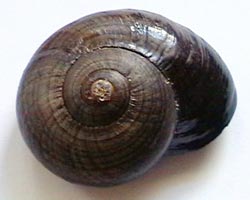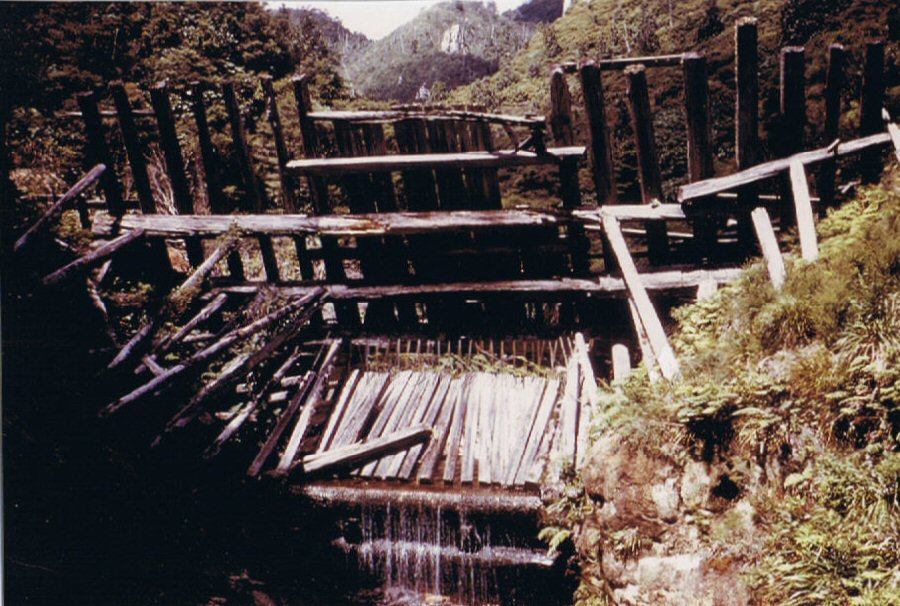|
Schizoglossa
''Schizoglossa'', common name the Paua slugs, is a genus of medium-sized to large predatory, air-breathing, land slugs, carnivorous terrestrial pulmonate gastropod molluscs in the family Rhytididae. They are currently classified by the New Zealand Department of Conservation as Nationally Vulnerable. Distribution The genus is endemic to the North Island of New Zealand (including the Great Barrier Island), Species and subspecies Species and subspecies within the genus ''Schizoglossa'' include: * ''Schizoglossa gigantea'' Powell, 1930 * ''Schizoglossa major'' Powell, 1938 - subfossil only *''Schizoglossa novoseelandica'' ( Pfeiffer, 1862) ** ''Schizoglossa novoseelandica novoseelandica'' ( Pfeiffer, 1862) ** ''Schizoglossa novoseelandica barrierensis'' Powell, 1949 * ''Schizoglossa worthyae'' Powell, 1949 Description The shell is small, rudimentary, auriform (ear-shaped) and is situated far back on the animal. The shell is incapable of containing the body, and is reduced to ... [...More Info...] [...Related Items...] OR: [Wikipedia] [Google] [Baidu] |
Schizoglossa Novoseelandica
''Schizoglossa novoseelandica'' is a predatory species of air-breathing land slug or semi-slug, a Terrestrial animal, terrestrial gastropod mollusc in the family (biology), family Rhytididae. It is the type species of the genus ''Schizoglossa'' and is found only in New Zealand. The survival of this species is not threatened; it is not listed in the 2009 ''IUCN Red List''IUCN 2009. IUCN Red List of Threatened Species. Version 2009.2. . Downloaded on 11 November 2009. nor is it in the 2005 ''New Zealand Threat Classification System lists''. Subspecies * ''Schizoglossa novoseelandica novoseelandica'' - on the New Zealand mainland. * ''Schizoglossa novoseelandica barrierensis'' - found only on Great Barrier Island. Distribution ''Schizoglossa novoseelandica novoseelandica'' is found on the North Island, List of non-marine molluscs of New Zealand, New Zealand.Arthur William Baden Powell, Powell A. W. B., ''New Zealand Mollusca'', William Collins Publishers Ltd, Auckland, New Zealand ... [...More Info...] [...Related Items...] OR: [Wikipedia] [Google] [Baidu] |
Schizoglossa Worthyae
''Schizoglossa worthyae'', is a species of large predatory, air-breathing, land slug, a carnivorous terrestrial pulmonate gastropod mollusc Mollusca is the second-largest phylum of invertebrate animals after the Arthropoda, the members of which are known as molluscs or mollusks (). Around 85,000 extant species of molluscs are recognized. The number of fossil species is esti ... in the family Rhytididae. References External links photo* Powell A W B, ''New Zealand Mollusca'', William Collins Publishers Ltd, Auckland, New Zealand 1979 New Zealand Department of Conservation Threatened Species Classification Gastropods of New Zealand Rhytididae Gastropods described in 1949 Taxa named by Arthur William Baden Powell {{Rhytididae-stub ... [...More Info...] [...Related Items...] OR: [Wikipedia] [Google] [Baidu] |
Schizoglossa Major
''Schizoglossa major'' was a species of large predatory, air-breathing, land slug, a carnivorous terrestrial pulmonate gastropod mollusc in the family Rhytididae. This species has only been found as a subfossil A fossil (from Classical Latin , ) is any preserved remains, impression, or trace of any once-living thing from a past geological age. Examples include bones, shells, exoskeletons, stone imprints of animals or microbes, objects preserved in .... References * Powell A W B, ''New Zealand Mollusca'', William Collins Publishers Ltd, Auckland, New Zealand 1979 External links * Gastropods of New Zealand Rhytididae Extinct animals of New Zealand Gastropods described in 1938 Taxa named by Arthur William Baden Powell {{Rhytididae-stub ... [...More Info...] [...Related Items...] OR: [Wikipedia] [Google] [Baidu] |
Schizoglossa Gigantea
''Schizoglossa gigantea'' is a species of large predatory, air-breathing, land slug; a carnivorous terrestrial pulmonate gastropod mollusc in the family Rhytididae. This species is endemic to the North Island of New Zealand. It was first discovered as 'subfossil A fossil (from Classical Latin , ) is any preserved remains, impression, or trace of any once-living thing from a past geological age. Examples include bones, shells, exoskeletons, stone imprints of animals or microbes, objects preserved in ... with moa bones, cave near Tahora, Gisborne District.' Further subfossil remains have been found in 'caves at Waikaremoana and Mangaone, near Nuhaka, Hawke Bay.'Powell, A.W.B. 1979: ''New Zealand Mollusca: marine, land and freshwater shells''. William Collins Publishers Ltd: Auckland. It has also been reported as 'living, WNW side of Mt. Hikurangi, East Cape area, 5753 feet.' In 2012, it was also reported that ' ''Schizoglossa gigantea'' has now been found iving?at four ... [...More Info...] [...Related Items...] OR: [Wikipedia] [Google] [Baidu] |
Rhytididae
Rhytididae is a taxonomic family of medium-sized predatory air-breathing land snails, carnivorous terrestrial pulmonate gastropod molluscs in the superfamily Rhytidoidea. MolluscaBase eds. (2020). MolluscaBase. Rhytididae Pilsbry, 1893. Accessed through: World Register of Marine Species at: http://www.marinespecies.org/aphia.php?p=taxdetails&id=816183 on 2020-10-22 This family has two subfamilies: * Chlamydephorinae Cockerell, 1935 (1903) * Rhytidinae Pilsbry, 1893 Anatomy In this family, the number of haploid chromosomes lies between 26 and 35 (according to the values in this table).Barker G. M. (2001). Gastropods on Land: ''Phylogeny, Diversity and Adaptive Morphology''. in Barker G. M. (ed.): The biology of terrestrial molluscs'. CABI Publishing, Oxon, UK, 2001, . 1-146, cited pages: 139 and 142. Distribution This family of land snails has a range which extends from South Africa to New Guinea, some of the higher South Pacific islands, New Zealand Powell A. W. B. (1979). ... [...More Info...] [...Related Items...] OR: [Wikipedia] [Google] [Baidu] |
Genus
Genus ( plural genera ) is a taxonomic rank used in the biological classification of extant taxon, living and fossil organisms as well as Virus classification#ICTV classification, viruses. In the hierarchy of biological classification, genus comes above species and below family (taxonomy), family. In binomial nomenclature, the genus name forms the first part of the binomial species name for each species within the genus. :E.g. ''Panthera leo'' (lion) and ''Panthera onca'' (jaguar) are two species within the genus ''Panthera''. ''Panthera'' is a genus within the family Felidae. The composition of a genus is determined by taxonomy (biology), taxonomists. The standards for genus classification are not strictly codified, so different authorities often produce different classifications for genera. There are some general practices used, however, including the idea that a newly defined genus should fulfill these three criteria to be descriptively useful: # monophyly – all descendants ... [...More Info...] [...Related Items...] OR: [Wikipedia] [Google] [Baidu] |
Great Barrier Island
Great Barrier Island ( mi, Aotea) lies in the outer Hauraki Gulf, New Zealand, north-east of central Auckland. With an area of it is the sixth-largest island of New Zealand and fourth-largest in the main chain. Its highest point, Mount Hobson, is above sea level.Great Barrier Island Aotea page on the DOC website (from the . Accessed 2008-06-04.) The is the [...More Info...] [...Related Items...] OR: [Wikipedia] [Google] [Baidu] |
Columella (gastropod)
The columella (meaning "little column") or (in older texts) pillar is a central anatomical feature of a coiled snail shell, a gastropod shell. The columella is often only clearly visible as a structure when the shell is broken, sliced in half vertically, or viewed as an X-ray image. The columella runs from the apex of the shell to the midpoint of the undersurface of the shell, or the tip of the siphonal canal in those shells which have a siphonal canal. If a snail shell is visualized as a cone of shelly material which is wrapped around a central axis, then the columella more or less coincides spatially with the central axis of the shell. In the case of shells that have an umbilicus, the columella is a hollow structure. The columella of some groups of gastropod shells can have a number of plications or folds (the columellar fold, plaits or plicae), which are usually visible when looking to the inner lip into the aperture of the shell. These folds can be wide or narrow, prominent ... [...More Info...] [...Related Items...] OR: [Wikipedia] [Google] [Baidu] |
Nacre
Nacre ( , ), also known as mother of pearl, is an organicinorganic composite material produced by some molluscs as an inner shell layer; it is also the material of which pearls are composed. It is strong, resilient, and iridescent. Nacre is found in some of the most ancient lineages of bivalves, gastropods, and cephalopods. However, the inner layer in the great majority of mollusc shells is porcellaneous, not nacreous, and this usually results in a non-iridescent shine, or more rarely in non-nacreous iridescence such as ''flame structure'' as is found in conch pearls. The outer layer of cultured pearls and the inside layer of pearl oyster and freshwater pearl mussel shells are made of nacre. Other mollusc families that have a nacreous inner shell layer include marine gastropods such as the Haliotidae, the Trochidae and the Turbinidae. Physical characteristics Structure and appearance Nacre is composed of hexagonal platelets of aragonite (a form of calcium carbonate) ... [...More Info...] [...Related Items...] OR: [Wikipedia] [Google] [Baidu] |
Gastropod Shell
The gastropod shell is part of the body of a Gastropoda, gastropod or snail, a kind of mollusc. The shell is an exoskeleton, which protects from predators, mechanical damage, and dehydration, but also serves for muscle attachment and calcium storage. Some gastropods appear shell-less (slugs) but may have a remnant within the mantle, or in some cases the shell is reduced such that the body cannot be retracted within it (semi-slug). Some snails also possess an operculum that seals the opening of the shell, known as the Aperture (mollusc), aperture, which provides further protection. The study of mollusc shells is known as conchology. The biological study of gastropods, and other molluscs in general, is malacology. Shell morphology terms vary by species group. Shell layers The gastropod shell has three major layers secreted by the Mantle (mollusc), mantle. The calcareous central layer, tracum, is typically made of calcium carbonate precipitated into an organic matrix known as c ... [...More Info...] [...Related Items...] OR: [Wikipedia] [Google] [Baidu] |
Proceedings Of The Linnean Society Of New South Wales
The Linnean Society of New South Wales promotes ''the Cultivation and Study of the Science of Natural History in all its Branches'' and was founded in Sydney, New South Wales ( Australia) in 1874 and incorporated in 1884. History The Society succeeded the ''Entomological Society of New South Wales'', founded in 1862 which folded in 1872, with James Charles Cox as its first president. The first issue of ''Proceedings'' was in 1875. The establishment of the Society was largely due to the dedication and financial support of its first President, Sir William Macleay. Joseph James Fletcher was director and librarian (this title was afterwards changed to secretary) from 1885 and edited 33 volumes of the ''Proceedings'' of the society. In September 1882, a fire destroyed the library and a part of the scientific material of the society. The efforts of William Macleay made it possible nevertheless for the society to continue its activities. Macleay bursary In 1903, the Society crea ... [...More Info...] [...Related Items...] OR: [Wikipedia] [Google] [Baidu] |
Ludwig Karl Georg Pfeiffer
Ludwig Karl Georg Pfeiffer, also known as Louis Pfeiffer (4 July 1805 – 2 October 1877), was a German physician, botany, botanist and conchology, conchologist. Early life, Education & Medical Career Louis Pfeiffer was born in Cassel, the eldest son of the jurist Burkhard Wilhelm Pfeiffer and his wife Louise (née Harnier). Pfeiffer received his primary education in the Friedrichsgymnasium Kassel, Cassel Lyceum, where he distinguished himself academically, and by the age of fifteen was already at the top of his class. In 1820, political tensions forced his father to relocate the family to Lübeck, but Louis continued to excel, reaching the top of his class there as well. At the age of sixteen, Pfeiffer entered into university to study medicine, first at the University of Göttingen, and finally at the University of Marburg, where he studied under such prominent scientists as Georg Wilhelm Franz Wenderoth and :de:Ernst Daniel August Bartels, Ernst Daniel August Bartels, graduating ... [...More Info...] [...Related Items...] OR: [Wikipedia] [Google] [Baidu] |







.jpg)